Pharmacological characterization of the ghrelin receptor mediating its inhibitory action on inflammatory pain in rats
- PMID: 22407485
- PMCID: PMC3448055
- DOI: 10.1007/s00726-012-1260-8
Pharmacological characterization of the ghrelin receptor mediating its inhibitory action on inflammatory pain in rats
Abstract
Recent research suggests a role for ghrelin in the modulation of inflammatory disorders. However, the type of ghrelin receptor (GHS-R) involved in both the anti-inflammatory and anti-hyperalgesic actions of ghrelin remains to be characterized. In this study, we examined whether the inhibitory effect of ghrelin in the development of hyperalgesia and edema induced by intraplantar carrageenan administration depends on an interaction with GHS-R1a. Both central (1 nmol/rat, i.c.v.) and peripheral (40 nmol/kg, i.p.) administration of the selective GHS-R1a agonist EP1572 had no effect on carrageenan-induced hyperalgesia measured by Randall-Selitto test and paw edema. Furthermore, pre-treatment with the selective GHS-R1a antagonist, D-lys(3)-GHRP-6 (3 nmol/rat, i.c.v.) failed to prevent the anti-hyperalgesic and anti-inflammatory effects exerted by central ghrelin administration (1 nmol/rat), thus indicating that the type 1a GHS-R is not involved in these peptide activities. Accordingly, both central (1 and 2 nmol/rat, i.c.v.) and peripheral (40 and 80 nmol/kg, i.p.) administration of desacyl-ghrelin (DAG), which did not bind GHS-R1a, induced a significant reduction of the hyperalgesic and edematous activities of carrageenan. In conclusion, we have shown for the first time that DAG shares with ghrelin an inhibitory role in the development of hyperalgesia, as well as the paw edema induced by carrageenan and that a ghrelin receptor different from type 1a is involved in the anti-inflammatory activities of the peptide.
Figures
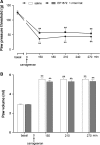
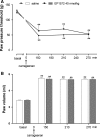
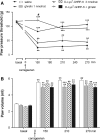
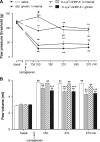
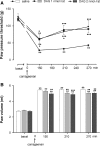
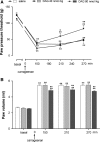
References
-
- Baldanzi G, Filigheddu N, Cutrupi S, Catapano F, Bonissoni S, Fubini A, Malan D, Baj G, Granata R, Broglio F, Papotti M, Surico N, Bussolino F, Isgaard J, Deghenghi R, Sinigaglia F, Prat M, Muccioli G, Ghigo E, Graziani A. Ghrelin and des-acyl ghrelin inhibit cell death in cardiomyocytes and endothelial cells through ERK1/2 and PI 3-kinase/AKT. J Cell Biol. 2002;159:1029–1037. doi: 10.1083/jcb.200207165. - DOI - PMC - PubMed
-
- Barnett BP, Hwang Y, Taylor MS, Kirchner H, Pfluger PT, Bernard V, Lin YY, Bowers EM, Mukherjee C, Song WJ, Longo PA, Leahy DJ, Hussain MA, Tschöp MH, Boeke JD, Cole PA. Glucose and weight control in mice with a designed ghrelin O-acyltransferase inhibitor. Science. 2010;330:1689–1692. doi: 10.1126/science.1196154. - DOI - PMC - PubMed
-
- Bednarek MA, Feighner SD, Pong SS, McKee KK, Hreniuk DL, Silva MV, Warren VA, Howard AD, Van Der Ploeg LH, Heck JV. Structure-function studies on the new growth hormone-releasing peptide, ghrelin: minimal sequence of ghrelin necessary for activation of growth hormone secretagogue receptor 1a. J Med Chem. 2000;43:4370–4376. doi: 10.1021/jm0001727. - DOI - PubMed
Publication types
MeSH terms
Substances
LinkOut - more resources
Full Text Sources
Medical

